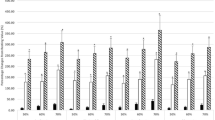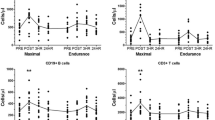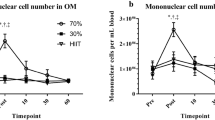Summary
A group of 11 healthy athletes [age, 27.4 (SD 6.7) years; body mass, 75.3 (SD 9.2) kg; height, 182 (SD 8) cm; maximal oxygen uptake, 58.0 (SD 9.9) ml · kg−1 · min−1] conducted maximal exercise of 60-s duration on a cycle ergometer [mean exercise intensity, 520 (SD 72) W; maximal lactate concentration, 12.26 (SD 1.35) mmol · l−1]. Adrenaline and noradrenaline, and leucocyte subpopulations were measured flow cytometrically at rest, after 5-min warming up at 50% of each individual's anaerobic threshold (followed by 5-min rest), immediately after (0 min), 15 min, 30 min, and 1, 2, 4 and 24 h after exercise. Granulocytes showed two increases, the first at 15 min and, after return to pre-exercise values, the second more than 2 h after exercise. Eosinophils also increased at 15 min but decreased below pre-exercise values 2 h after exercise. Total lymphocytes and monocytes had their maximal increases at 0 min. Out of all lymphocyte subpopulations CD3−CD16/CD56+- and CD8S+ CD45RO−-cells increased most and had their maximal cell counts at 0 min. The CD3+-, CD4+CD45RO+-, CD8+ CD45RO+-, and CD19+- increased at 0 min, but had their maximum at 15 min. During the hours after exercise CD3− CD16/CD56+-, CD3+CD16/CD56+-, CD8+CD45RO+- and CD8+ CD45RO−-cells were responsible for the lymphocytopenia. The CD3+- and CD3− CD16/CD56+-cells were lower 24h after exercise than before exercise. Adrenaline and noradrenaline increased during exercise. In conclusion, short anaerobic exercise led to a sequential mobilization of leucocyte subpopulations. The rapid increase of natural killer cells and monocytes may have been due to increased blood flow and catecholamine concentrations. We interpreted from these results that those cells forming the first line of defence can be mobilized faster and disappear out of circulation more rapidly than all other cell populations.
Similar content being viewed by others
References
Berk LS, Niemann DC, Youngberg WS, Arabatzis K, Simpson-Westerberg M, Lee JW, Tan SA, Eby WC (1990) The effect of long endurance running on natural killer cells in marathoners. Med Sci Sports Exerc 22:207–212
Da Prada M, Zürcher G (1976) Simultaneous radioenzymatic determination of plasma and tissue adrenaline, noradrenaline, and dopamine within the femtomole range. Life Sci 19:1161–1174
Deuster PA, Curiale AM, Cowan ML, Finkelman FD (1988) Exercise-induced changes in populations of peripheral blood mononuclear cells. Med Sci Sports Exerc 20:276–280
Dill DB, Costill DL (1974) Calculation of percentage changes of blood, plasma, and red cells in dehydration. J Appl Physiol 37:247–248
Ferry A, Picard F, Duvallet A, Weill B, Rien M (1990) Changes in blood leucocyte populations induced by acute maximal and chronic submaximal exercise. Eur J Appl Physiol 59:435–442
Fiatorone MA, Morley JE, Bloom ET, Benton D, Solomon GF, Makinodan T (1989) The effect of exercise on natural killer cell activity in young and old subjects. J Gerontol 44:M37–45
Gabriel H, Urhausen A, Kindermann W (1991) Circulating leucocyte and lymphocyte subpopulations before and after intensive endurance exercise to exhaustion. Eur J Appl Physiol 63:449–457
Gabriel H, Schwarz L, Steffens G, Kindermann W (1992) Immunoregulatory hormones, circulating leucocyte and lymphocyte subpopulations before and after endurance exercise of different intensities. Int J Sports Med (in press)
Gastrin P, Lawson D, Hargreaves M, CareY M, Fairweather I (1991) Variable resistance loadings in anaerobic power testing. Int J Sports Med 12:513–518
Hoffmann-Goetz L, Simpson JR, Cipp N, Arumugam Y, Houston ME (1990) Lymphocyte subset responses to repeated submaximal exercise in men. J Appl Physiol 68:1069–1074
Hohorst HJ (1962) L-(+)-Lactat, Bestimmung mit Lactatdehydrogenase und DPN. In: Bergmeyer HU (ed) Methoden der enzymatischen Analyse. Chemie, Weinheim
Kappel, M, Tvede N, Galbo H, Haahr PM, Kjaer M, Linstow M, Klarlund M, Pedersen PK (1991) Evidence that the effect of physical exercise on NK cell activity is mediated by epinephrine. J Appl Physiol 70:2530–2534
Keast D, Cameron K, Morton AR (1988) Exercise and immune response. Sports Med 5:248–267
Kendall A, Hoffmann-Goetz L, Houston ME, MacNeil B, Arumugam Y (1990) Exercise and blood lymphocyte subset responses: intensity, duration, and subject fitness effects. J Appl Physiol 69:251–260
Landmann RMA, Bürgisser E, Wesp M, Bühler FR (1984) Betareceptors are different in subpopulations of human circulating lymphocytes. J Recept Res 4:37–50
Lanier LL, Le AM, Civin CI, Loken MR, Phillips JH (1986) The relationship of CD16 (Leu-11) and Leu-19 (NKH-1) antigen expression on human peripheral blood NK cells and cytotoxic T lymphocytes. J Immunol 136:4480–4486
Mackinnon LT (1989) Exercise and natural killer cells. What is the relationship? Sports Med 7:141–149
Medbo JI, Tabata I (1989) Relative importance of aerobic and anaerobic energy release during short-lasting exhausting bicycle exercise. J Appl Physiol 67:1881–1886
Niemann DC, Berk LS, Simpson-Westerberg M, Arabatzis K, Youngberg WS, Tan SA, Lee JW, Eby WC (1989) Effects of long-endurance running on immune system parameters and lymphocyte function in experienced marathoners. Int J Sports Med 10:317–323
Pedersen BK, Tvede N, Klarlund K, Christensen LD, Hansen FR, Galbo H, Kharazmi A, Halkjer-Kristensen J (1990) Indomethacin in vitro and in vivo abolishes post exercise suppression of natural killer cell activity in peripheral blood. Int J Sports Med 11:127–131
Stauber WT, Fritz VK, Vogelbach DW, Dahlmann B (1988) Characterization of muscle injured by forced lenghthening. I. Cellular infiltrates. Med Sci Sports Exerc 20:345–353
Stegmann H, Kindermann W, Schnabel H (1981) Lactate kinetics and individual anaerobic threshold. Int J Sports Med 2:160–165
Tvede N, Pedersen BK, Hansen FR, Bendix T, Christensen LD, Galbo H, Halkjer-Kristensen J (1989) Effect of physical exercise on blood mononuclear cell subpopulations and in vitro proliferative responses. Scand J Immunol 29:383–389
Withers RT, Sherman WM, Clark DG, Esselback PC, Nolan MH, Brinkman M (1989) Muscle metabolism during 30, 60 and 90 s of maximum cycling on an air-braked ergometer (abstract). Proc Aust Physiol Pharmacol Soc 20:60P
Author information
Authors and Affiliations
Rights and permissions
About this article
Cite this article
Gabriel, H., Urhausen, A. & Kindermann, W. Mobilization of circulating leucocyte and lymphocyte subpopulations during and after short, anaerobic exercise. Europ. J. Appl. Physiol. 65, 164–170 (1992). https://doi.org/10.1007/BF00705075
Accepted:
Issue Date:
DOI: https://doi.org/10.1007/BF00705075




